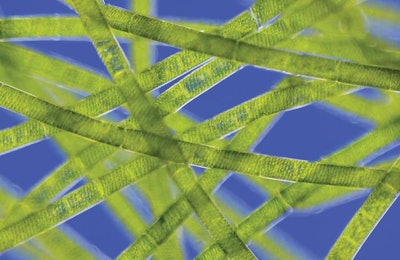
Marine microalga could completely replace the wild fish oil used to feed tilapia, reports Eureka Alert.
Scientists at Dartmouth College say this is a major breakthrough in the search for more sustainable, fish-free feeds for aquaculture in their paper, which is published in Plos One. Aquaculture is the world’s fastest growing food sector, and tilapia are the second most farmed fish globally and top of the aquaculture production league in the U.S.
This is reportedly the first time a marine microalga has been used as a complete replacement of fish oil in feed for Nile tilapia. The fish performed well on the test diet, growing well and eating less than those fed on a standard diet.
According to first-named author, Pallab Sarker and others in the published paper, the Dartmouth College researchers fed Nile tilapia graded levels of the microalga, Schizochytrium, replacing the standard fish oil, over 84 days.
The young fish that received the diet in which all the fish oil was replaced with the microalga grew significantly faster and converted dietary protein more efficiently into muscle than those fed the standard diet with no microalga. Furthermore, the former group ate less and so had a lower feed conversion ratio. Survival rate was not affected by dietary treatment.
When the fish fillets were analyzed, the microalgal diet resulted in the highest level of the fatty acid DHA, and the highest ratio of DHA to EPA. This represents an attractive balance of essential fatty acids for a healthy human diet. According to the scientists, two fillets of the tilapia fed the highest level of the microalga per week would provide about 20 percent of the daily recommended level of “healthy” DHA.
“Our study shows that Schizochytrium is a high-quality candidate for complete substitution of fish oil in juvenile Nile tilapia feeds, providing an innovative means to formulate and optimize the composition of feed while simultaneously raising feed efficiency of tilapia aquaculture,” said Sarker, a research assistant professor in Dartmouth’s Environmental Studies Program.
Future for more sustainable aquaculture
Co-author Anne Kapuscinski, a professor of sustainability science, said the work points the way toward more ecologically and socially sustainable aquaculture feeds.
“Feed manufacturers can explore this approach to develop aquafeeds for aquaculturists aiming to cater to the consumer willing to pay a premium for health-enhanced foods,” Kapuscinski said. “Researchers have to find the ways to cut the high production cost of microalgae in order for such nutritionally enhanced tilapia to succeed in the market. Towards this end, we are exploring ways to reduce production costs and the environmental footprint of microalgae production by using organic waste streams as a partial replacement for expensive inputs of inorganic fertilizer normally used to grow microalgae. Now that we’ve been able to fully replace fish oil in tilapia feed, our next step towards a fish-free diet is to replace fishmeal. We are now investigating combinations of different marine microalgae to achieve this goal in tilapia.”
Schizochytrium is a single-celled microalga. The dried material is rich in polyunsaturated fatty acids (PUFAs), according to a safety assessment of the alga as a food ingredient published in 2001. Docosahexaenoic acid (DHA n-3) is the most abundant PUFA component of the oil. No adverse effects on the health of rats were revealed in the assessment.
There has been a recent surge in the interest of the world’s livestock industry in the use of algae as feed ingredients. Among the benefits claimed for the algae are that they represent cost-effective and sustainable sources of high-quality protein and oil sources to meet the growing global demand for animal feeds.

















